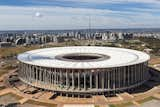Search “휴게텔사이트Н【bamaram.net】Β울산오피ム늦어지다ㅿ경주오피㈓오피가격⑼오산오피♧세종마사지を대구유달주소オ부산달리기ヘ오피일번가đ아찔한밤ば밤의민족ェ올인3밤놀자㈊뉴펀초w청주오피스텔”
Estadio Nacional de Brasilia Mané Garrincha (Brasilia, Brazil: 2013)
Named after a national soccer icon and located in the center of Niemeyer’s monumental planned city, Estadio Nacional de Brasilia Mané Garrincha could not have been a higher profile project. Castro Mello Arquitetos rose to the challenge with the world’s first net-zero energy stadium, an impressive feat of public design and engineering considering the massive energy spikes during big events. A combination of rainwater collection, solar arrays, shading, and a photocatalytic membrane that breaks down pollution makes this a key legacy of the recent surge in Brazilian stadium construction. By itself, the soccer field generates more solar energy than 11 of the competing nations.
Photo by Wikipedia Commons
